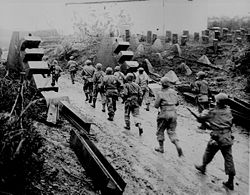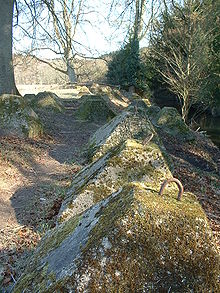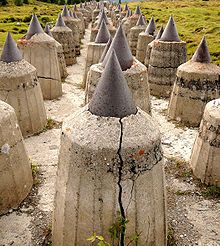- Dragon's teeth (fortification)
-
Dragon's teeth (German: Drachenzähne, literally "dragon teeth") are square-pyramidal fortifications of reinforced concrete first used during the Second World War to impede the movement of tanks and mechanised infantry. The idea was to slow down and channel tanks into "killing zones" where they could easily be disposed of by anti-tank weapons.
They were employed extensively, particularly on the Siegfried Line.
In practice, the use of combat engineers and specialist clearance vehicles enabled them to be disposed of relatively quickly, and they proved far less of an obstacle than many had expected.
Contents
World War II
Dragon's teeth were extensively used by all sides in the European Theatre. The Germans made extensive use of them in the Siegfried Line and the Atlantic Wall. Typically, each "tooth" was 90 to 120 cm (3 to 4 ft) tall depending on the precise model.
Land mines were often laid between the individual "teeth", and further obstacles constructed along the lines of "teeth" (such as barbed wire to impede infantry, or diagonally-placed steel beams to further hinder tanks). The French army employed them in the Maginot Line, while many were laid in the United Kingdom in 1940–1941 as part of the effort to strengthen the country's defences against a possible German invasion.
Behind minefields were the dragon's teeth. They rested on a concrete mat between ten and thirty meters wide, sunk in a meter or two into the ground (to prevent any attempt to tunnel underneath them and place explosive charges). On top of the mat were the teeth themselves, truncated pyramids of reinforced concrete about a meter in height in the front row, to two meters high in the back. They were staggered and spaced in such a manner that a tank could not drive through. Interspersed among the teeth were minefields, barbed wire, and pillboxes that were virtually impregnable by the artillery and set in such a way as to give the Germans crossing fire across the entire front. The only way to take those pillboxes was for infantry to get behind them and attack the rear entry. But behind the first row of pillboxes and dragon’s teeth, there was a second, and often a third, and sometimes a fourth.—[1]Due to the huge numbers laid and their durable construction, many thousands of dragon's teeth can still be seen today, especially in the remains of the Siegfried and Maginot Lines.
Post World War II
Switzerland continues to maintain lines of dragon's teeth in certain strategic areas. In the military jargon these constructions are often referred to as 'Toblerone lines', after the chocolate bar.[2]
Dragon's teeth are also present in some areas along the Korean DMZ borderline as well as the Eastern Side of the Berlin Wall.
The term has survived into the present day and now also can be used to describe any line of posts or pegs set into the ground to deter vehicle access, for example in rural car parking areas, or alongside roads. Bollard is another term for such a post.
Some countries, such as those made after the breakup of Yugoslavia, have movable teeth, positioned at roadsides at strategic locations, which are to be lifted and placed on the roads.
See also
References
- ^ Stephen Ambrose, The Victors: Eisenhower and his Boys — The Men of World War II (New York: Simon & Schuster, 1998), pg 256
- ^ Muehlemann, Anetka (9 June 2008). "Ligne fortifiée, un témoin du passé à valoriser" (in French). 24 Heures, Edipresse, Switzerland. http://www.24heures.ch/vaud/actu/2008/06/09/ligne-fortifiee-temoin-passe-valoriser. Retrieved 2009-08-09.[dead link]
External links
- The Toblerone trail
- Dragon's Teeth in Horsham, West Sussex
- "You Build 'Em - We'll Bust 'Em." Popular Science, June 1942, pp. 106-112. Field expedient tank traps constructed of logs.
- White Cliffs Underground - Dragon's Teeth and Tank Traps around England's south coast
- Dragons Teeth on Libyan border with Egypt [1]
- "ANTI-TANK OBSTACLES, ISLE OF GRAIN, KENT". English Heritage. http://www.english-heritage.org.uk/protecting/heritage-protection/showcase/case-studies/anti-tank-obstacles/. Retrieved 28 July 2010.
Categories:- Anti-tank obstacles
- Fortification
Wikimedia Foundation. 2010.




